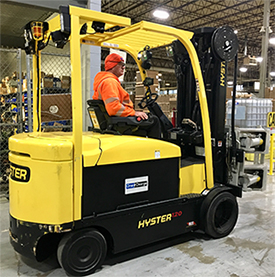OneCharge and its Li-ion Batteries main product line was featured in a recent DC Velocity article by Victoria Kickham, Senior Editor. The promise of greater productivity and reduced maintenance is driving interest in lithium-ion batteries for material handling equipment.
Demand for a more efficient supply chain is shining a light on today’s warehouse operations, a trend that’s sparking interest in alternative power solutions for industrial trucks. Of those alternatives to the traditional lead-acid battery, one in particular—the lithium-ion battery—has captured the market’s attention.
Experts say productivity is at the heart of the issue, as fleet managers look for ways to work smarter and maximize equipment uptime. But industry adoption of lithium-ion batteries is still far from widespread, as higher acquisition costs and other factors make the technology suitable mainly for operations running large forklift fleets and/or making heavy use of their equipment.
Still, interest is growing, and battery makers say alternative power solutions will soon see wider adoption. That’s why they’re stepping up to the plate with solutions designed to “take away the pain points” customers are experiencing, explains Harold Vanasse, senior director of marketing, motive power Americas, for Reading, Pa.-based battery power solutions provider and battery manufacturer EnerSys, which showcased its new line of NexSys iON lithium-ion batteries and accessories at this spring’s ProMat trade show in Chicago. He emphasizes the ever-present drive to become more productive, reduce downtime, maximize facility space, and minimize maintenance requirements.
“There’s one thing driving this trend: the benefits the technology brings, especially its zero maintenance,” Vanasse says of the rise of lithium-ion batteries, which unlike their lead-acid counterparts, don’t require the labor-intensive process of watering. With lead-acid batteries, water inside the battery is consumed during operation and must be replenished. Staff must monitor batteries and water them on a regular schedule, a process that takes time, dedicated warehouse space, and equipment. Eliminating those requirements contributes to a more efficient and productive warehouse operation, lithium proponents say.
“That’s the drive” behind today’s battery innovations, Vanasse says.
ADVANCEMENTS IN TECHNOLOGY AND THE “WOW” FACTOR
You didn’t have to walk too many aisles at the ProMat show to witness the growth in lithium solutions for material handling equipment. The biennial trade show highlights the newest innovations in manufacturing, distribution, and supply chain technology, and this year, dozens of manufacturers featured lithium batteries as well as equipment powered by lithium solutions. The sense of “newness” surrounding the products is bringing a “wow” factor to an industry that has seen little innovation in the last 100 years or so, industry experts say.
 “[Lithium] signifies the advance of new technology in an industry that has been very traditional and has not seen much innovation,” says Max Khabur, head of marketing for Irvine, Calif.-based lithium-battery maker OneCharge. “When there is something new to talk about … it brings a lot of excitement and a new competitive angle to a very traditional industry.” Founded in 2015, OneCharge makes lithium-ion batteries for material handling equipment and offers more than 450 models for Class I, II, and III forklifts. Khabur compares the growing popularity of lithium power for material handling applications with the rise of electric cars and trucks: As lithium-battery technology has advanced and become broadly accepted in the consumer market, there’s been increasing interest in applying it in the industrial sector, he says. The interest is fueling market growth: The overall lithium-ion battery market is expected to reach $93 billion by 2025, a 17-percent compound annual growth rate, according to a 2019 study by market research firm Grand View Research. Automobiles and other consumer electronics are expected to drive the bulk of that growth, but industrial and material handling applications will contribute as well, industry experts say.
“[Lithium] signifies the advance of new technology in an industry that has been very traditional and has not seen much innovation,” says Max Khabur, head of marketing for Irvine, Calif.-based lithium-battery maker OneCharge. “When there is something new to talk about … it brings a lot of excitement and a new competitive angle to a very traditional industry.” Founded in 2015, OneCharge makes lithium-ion batteries for material handling equipment and offers more than 450 models for Class I, II, and III forklifts. Khabur compares the growing popularity of lithium power for material handling applications with the rise of electric cars and trucks: As lithium-battery technology has advanced and become broadly accepted in the consumer market, there’s been increasing interest in applying it in the industrial sector, he says. The interest is fueling market growth: The overall lithium-ion battery market is expected to reach $93 billion by 2025, a 17-percent compound annual growth rate, according to a 2019 study by market research firm Grand View Research. Automobiles and other consumer electronics are expected to drive the bulk of that growth, but industrial and material handling applications will contribute as well, industry experts say.
“Just a couple of decades ago, [lithium] was still unheard of in this market,” explains Khabur. “Now, the technology is evolving … And, as with every new technology, there are more and more competitors.”
“The newer technologies are certainly out there, with lithium being the buzzword [today],” adds Brian Faust, general manager for Reading, Pa.-based battery, charger, and accessories manufacturer Douglas Battery, which offers traditional lead-acid batteries and is also developing a sealed lead-acid product, expected to be available next year. Sealed lead-acid batteries offer similar benefits to lithium-ion solutions, including zero maintenance because they also don’t need to be watered. “Probably over the next two or three years we’ll see where [alternative power] settles down in our industry.”
BENEFITS ABOUND, BUT QUESTIONS LINGER
Khabur and others agree that, today, lithium-ion batteries are best suited to operations where lift trucks are used for two or three shifts a day. Typical OneCharge customers have multiple pieces of equipment and are looking to get the most out of the vehicles during every shift, Khabur says.
“Our clients want to use the machinery with maximum efficiency,” he says, pointing to the convenience and productivity-enhancing features of the technology as key selling points. Among other benefits, lithium-ion batteries charge faster and run longer than traditional solutions, eliminating the need to change a forklift battery at each shift, experts say. Their lifespan is also more than twice as long as their lead-acid counterparts’. And as Vanasse pointed out, they don’t require watering, which eliminates the need for dedicated battery maintenance space and reduces labor requirements. The technology also helps reduce energy use because lithium-ion units use less electricity for charging, Khabur explains. On the downside, lithium-ion batteries still cost about three times as much as traditional lead-acid units, although the purchase price has come down in recent years. Khabur says that barrier will shrink as the technology evolves.
“Each year, we are [developing] new and more effective batteries,” he says, adding that OneCharge sold 1,200 batteries in 2018 and hopes to double that in 2019.
Although the benefits and the newness of the technology will continue to garner attention for the products, questions linger over how quickly they’ll move into widespread use. Experts point out that although both lithium-ion and sealed lead-acid batteries are maintenance-free in comparison to lead-acid batteries, they don’t eliminate **ital{all} the maintenance associated with battery-powered material handling equipment. Lithium-ion batteries still require periodic inspection of cables, terminals, and the like, and forklifts themselves still require routine maintenance.
Battery end-of-life is also a sticking point. Virtually all lead-acid batteries are recycled by the manufacturer, a service included in the cost of the battery, according to Faust and others. In the United States, 99 percent of all lead-acid batteries are recycled, the highest percentage of any U.S. product, says John Connell, vice president of battery manufacturer Crown Battery’s SLI Product Group. He adds that lead-acid battery makers largely rely on recycled lead to produce new batteries.
That’s not the case with lithium-ion batteries, which are more complex and costly to recycle. Currently, lithium batteries are collected and recycled at a rate of less than 5 percent, according to the U.S. Department of Energy (DOE), which launched a program to boost the recycling rate earlier this year. In February, the DOE announced the opening of a battery-recycling center at Argonne National Laboratory in Chicago aimed at reclaiming and recycling critical materials from lithium batteries, with the goal of recovering 90 percent of key materials. In the meantime, the material handling industry is also researching the best end-of-life solutions, which include reuse and repurposing lithium-ion batteries for other energy needs, according to Khabur, who adds that OneCharge has a few batteries in the field that are nearing the end of their five-year warranty and may last well beyond it.
“If taken good care of and charged often, [these batteries] will last longer,” he says. “And they can be repurposed. There may be many other uses. There is still much research and development [under way].”
IT’S ALL ABOUT PRODUCTIVITY
Regardless of how it all plays out, most experts agree that in the eyes of the end user, the technology inside the forklift doesn’t really matter, as long as the product delivers the power to do the job efficiently and effectively.
“End users couldn’t care less about what kind of battery is in their truck,” Khabur says. “It’s not a crucial detail for their business. What matters when they are looking for a solution [is that] it delivers the promised benefits and does not require everyday maintenance.”
Faust adds that when it comes to batteries, end users are most concerned about uptime—and cost.
“[Customers] want their batteries to run longer and require less maintenance because that increases productivity. But not everybody wants to pay for it,” he explains, circling back to the higher initial costs of lithium-ion units and the resulting need to choose the solution that makes the most sense for a given application.
You can find the original publication here.
 by Alex Pisarev | July 8, 2019
by Alex Pisarev | July 8, 2019